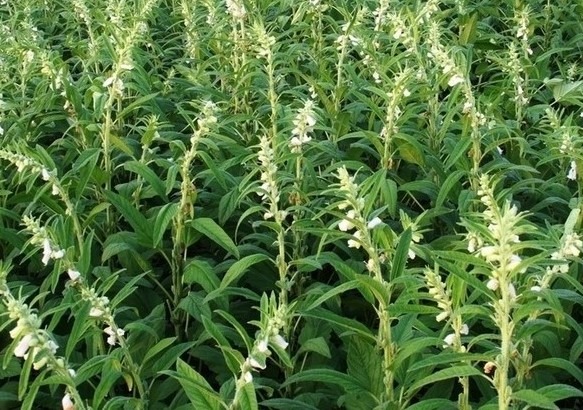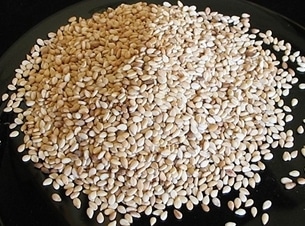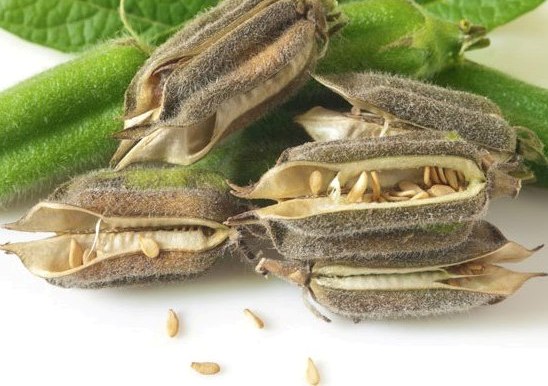Sesame Farming Guide:

Introduction of Sesame: – Sesame is one of the oldest oilseed crops and an important oil yielding crop with oil content of 40 to 50 % and popularly known as ‘Til’ or ‘Gingelly’.The sesame seeds or its powder or its oil used in various Indian dishes as a flavouring agent. In India the sesame crop can be cultivated as Kharif, summer, and also as semi-rabi crop. Sesame seeds are tiny, flat oval seeds with a nutty taste and almost invisible crunch. Depending upon the variety of seed they come in different colours like white, yellow, black & red. 75 % of the sesame seed cultivated during the kharif season in India.
Health Benefits of Sesame (or) Gingelly (or) Til: – Some of the health benefits of Sesame are given below.
- Sesame is very good source of protein.
- Sesame seeds help in preventing diabetes.
- Sesame seeds help in reducing blood pressure.
- Sesame seeds help in lowering cholesterol.
- Sesame seeds help in for digestion.
- Sesame seeds help in alleviates anaemia.
- Sesame seeds protects liver from alcohol.
- Sesame seeds help in preventing wrinkles.
- Sesame seeds help in bone health and prevent osteoporosis.

Health benefits of sesame seeds.
Local Names for Sesame in India:- Til (Hindi), Ellu (Tamil), Nuvvulu(Telugu), Til (Marathi), Tul (Gujarati), Ellu(Malayalam),Ellu Beeja (Kannada),Tila bīja (Punjabi), Raashi/Rasi (Oriya).
Major Sesame seed producers in India: – Sesame seed is largely grown in the eastern and western parts of the India. The major producers of sesame seed states are West Bengal, Gujarat, West Bengal, Tamil Nadu, Andhra Pradesh, Telangana, Madhya Pradesh, Maharashtra & Rajasthan.
Commercial or Hybrid Varieties of Sesame:- Following are the hybrid varieties of sesame seeds.
CO-1,TMV-3,TMV-4,TMV-5,TMV-6,TMV-7,VRI(SV)-1,VRI(SV)-2,SVPR-1.
Soil Requirement for Sesame Farming:- The sesame crop grown as summer crop, Kharif crop and also as semi-rabi crop. Sesame thrives well on soils with neutral reaction (or) slightly acidic type. There should not be any water stagnation in the soil, so make sure soil is well drained and light loamy soil for better growth performance. The preferred soil pH range of sesame crop is 5.5 to 8.0. Saline soils or too much sandy soils are not suitable for sesame cultivation. Adding well rotten Farm Yard Manure to the soil is beneficial in getting higher yields.
Agro-Climatic Condition required for Sesame Farming:- This crop can be cultivated @ elevations up to 1250 m. Sesame crop does not grown in frost conditions., Prolonged drought (or) heavy rains are not favourable conditions for its cultivation. Sesame crop is a tropical crop and this crop requires hot conditions during its growth period for best yield. Ideal temperature for sesame cultivation is between 25 °C – 30 °C, Extreme low and very high temperatures effect the growth.
Land Preparation in Sesame Farming:- The land should be ploughed by tractor or desi/country plough and harrowed repeatedly for bridging the soil to fine tilth and weed free for quick germination as the sesame seeds are small. Add appropriate Farm Yard Manure while preparing the soil or beds.
Seed Rate and Seed Treatment in Sesame Farming:- Seed rate depends on sowing method and variety of seed. And season In broadcasting method, under rain fed conditions seed rate would be 6 kg/hectare, under irrigated conditions 5 kg/hectare. in row seeding, under rain fed condition seed rate would be 5 kg/hectare, under irrigated condition 4 kg/hectare. If sesame is cultivated as intercrop, seed rate would be 1 kg/hectare.Treat the seeds with Thiram (3 grams / kg of seeds) to prevent seed borne diseases. Just before seeding, seeds should be soaked in 0.03% Agrimycin- 100 solution for 25 to 30 minutes to minimize leaf spot disease.
Sowing and Spacing in Sesame Farming:- Sowing of sesame can be done in broadcast or line. However sowing the seeds in lines is preferred. Mixing the seed with dry sand (1 time seed: 4 times dry sand) and spread the mixture along the furrows to ensure even distribution. 3cm depth is enough for sowing the seeds and cover the seeded area with soil. Make row-to-row spacing of 25 cm to 35 cm and plant-to-plant spacing of 10 cm to 20 cm.
Weed Control/Intercultural Operations in Sesame Farming:- First 15 to 25 days after sowing is crucial for weeding. The irrigated sesame crop requires frequent weeding operations where as rainfed crop requires once or twice. One weeding should be carried out @ 2 weeks of sowing and another one @ 30 to 35 days to keep the crop weed free. Row seeded sesame crop requires blade harrowing for intercultivation.2 such tasks should be carried out 1 is @ 15 days (after sowing) other one is @ 30 to 35 days (after sowing) followed by one hand weeding. Use herbicides Thiobencarb (2.0kg/hectare) (or) Alachlor (1kg/hectare) as pre emergence spray to control the weeds.
Irrigation in Sesame Farming:- Irrigate the field @ sowing to keep enough moisture for good germination. Depending upon the soil type and climatic condition, provide life irrigation @ 7 days after sowing.There are 3 critical stages of watering in sesame farming, first one @ pre-flowering stage (22-25 days after sowing), second one @ flowering stage (35 to 45 days after sowing) & 1 (or) 2 irrigations @ pod setting stage. During the seed maturity stage, maintain low moisture status because seed maturity is affected and filling up of the capsules would be poor. Hence, stop watering after 65 to 70 days of sowing.
Manures and Fertilizers in Sesame Farming:- Add 5 to 6 tonnes of Farm Yard Manure (F.M.Y) or well rotten compost at the time of soil preparation. Fertilizers for rainfed and irrigated conditions are as follows:
Rainfed Crop–> ½ basal · N 40 kg/hectare. P 60 kg/hectare (30 to 35 days after sowing). K 40 kg/hectare.
Irrigated Crop –> ½ basal · N 60 kg/hectare. P 61 kg/hectare (30 to 35 days after sowing). K 40 kg/hectare.
Note:Applying of fertilizer @ seeding using seed drills is more effective than broadcast method.
Pests and Diseases in Sesame Farming:- Caterpillar and Gall fly are the main pests in the sesame cultivation. To control these, apply 2 sprays of caterpillar and gall fly (or) Carbaryl 0.2% on 40 th and 60 th day after sowing. Other diseases found in sesame farming are Phyllody or leaf-curl and leaf-spot. To control leaf-spot, apply 3 sprays of Agrimycin @ the rate of 100 PPM at 2 weeks interval and to control Phyllody or leaf-curl, spray Dimethoate 0.05% (or) Phosphomidan.
Harvesting of Sesame Seed:- Depending on the variety, this crop comes to maturity in 3 to 5 months. Harvesting can be started when the leaves, stems and capsules begin to turn yellow and the lower leaves of the plant start shedding. Don’t wait until the crop becomes dead ripe which will cause the shedding of seed. The ripe sesame plants should be cut @ the ground level and should be stacked for 7 to 10 days in sun to make them ready for threshing.

Yield of Sesame Seed:- Yield always depends on variety and good farm management practices. For Kharif crop an average of 200 to 500 Kg/ha, for summer irrigated crop & semi rabi crop,300 to 600 Kg/ha can be achieved.
Want information about Sheep Farming (or) Goat Farming? Read Here.
Am very glad to came across ur website, I do welcome your guidance via ur soft copy shearing on mails.
Thanks.